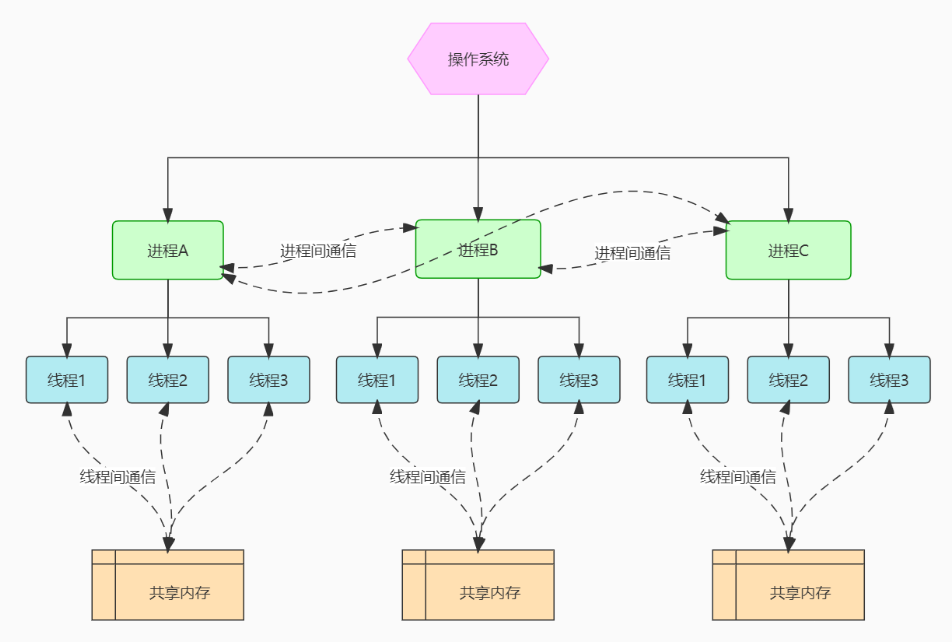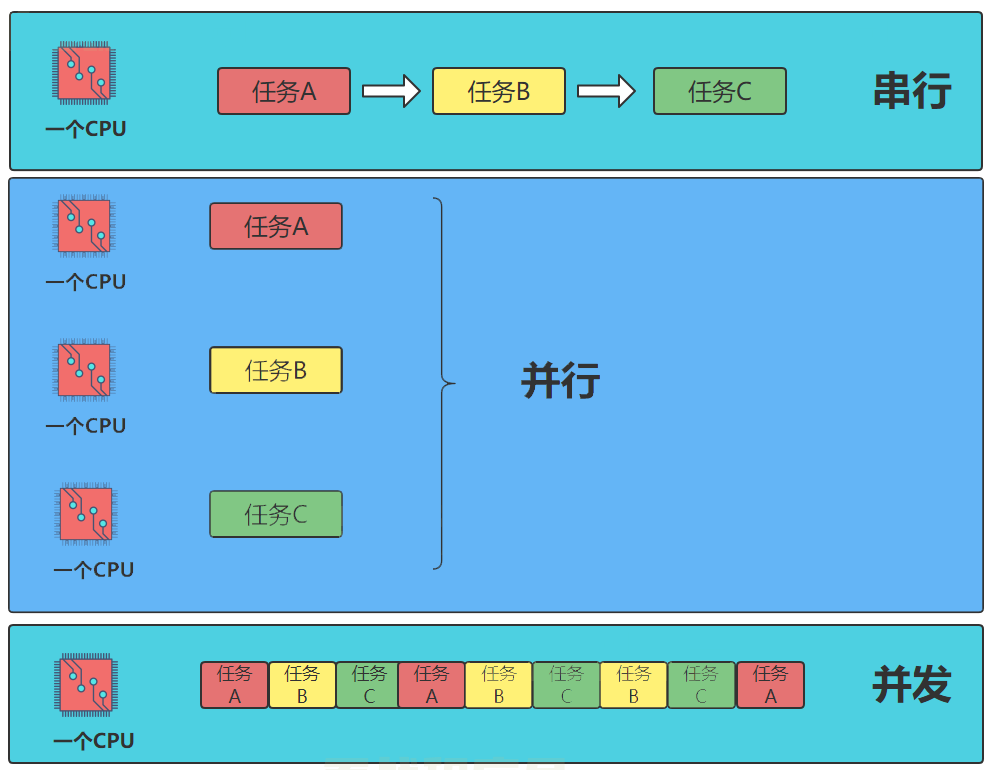前言
多线程相关操作,Linux选择使用的是POSIX标准,而Windows自己搞了一套系统调用,称为Win32 API,意味着Linux与Windows存在标准差异,直接导致能在Linux中运行的程序未必能在Windows中运行。
C++11之前,编写多线程相关代码为保证兼容性,需要借助条件编译,分别实现两份代码,根据不同平台编译不同的代码,非常麻烦。
// 确保平台兼容性
#ifdef __WIN_32__
CreateThread // Windows 中创建线程的接口
// ...
#else
pthread_create // Linux 中创建线程的接口
// ...
#endif
C++11中加入了线程库标准,其中包含了线程、互斥锁、条件变量等常用线程操作,不需要依赖第三方库,保障了代码的可移植性。除此之外,线程库还新加入了原子相关操作。
线程与进程
- 进程:是操作系统进行资源分配和调度的一个独立单位,是应用程序运行的实例。每个进程都有自己的独立内存空间。
- 线程:是进程中的执行单元,多个线程共享同一进程的内存空间和资源,但每个线程有自己的栈、程序计数器等。线程是CPU调度的基本单位。

并发与并行
- 并发:在同一时间间隔发生,并发是针对单核 CPU 提出的,在同一CPU上的多个事件。
- 并行:是指两个或者多个事件在同一时刻发生,并行则是针对多核 CPU 提出,在不同CPU上的多个事件。

多线程是实现并发|并行的手段。一般而言,多线程就是把执行一件事情的完整步骤拆分为多个子步骤,然后使得这多个步骤同时执行。
同步和互斥
- 线程同步是指多个线程按照一定规律协调工作,使得这些线程在空间、时间上按照既定规律有序地执行工作。实现方式一般有:互斥量(Mutex)、信号量(Semaphore)、事件(Event)、条件变量(Condition Variable)
- 线程互斥是指在多线程环境下,所有线程都要访问共享资源,但同一时刻只能有一个线程访问。实现方式一般有:互斥量(Mutex)、信号量(Semaphore)
线程
线程库:#include <thread>,先创建线程对象,可以关联一个线程,用来控制该线程以及获取线程的状态。
线程对象构造
无参构造
创建无实际线程关联的对象。后续需要让该线程对象与线程函数关联时,可以以带参的方式创建一个匿名对象,然后调用移动赋值将该匿名对象关联线程的状态转移给该线程对象。
thread t1;
//...
t1 = thread(func, 10);
// 线程启动后,在线程对象销毁前,等待启动的线程完成,才会继续往下执行
t1.join();
带可变参数包的构造
支持函数模板的可变参数,包括函数指针、函数对象、lambda表达式。该构造函数其实就是一个模板函数template <class Fn, class... Args> explicit thread (Fn&& fn, Args&&... args)。
// 自定义函数
void func1(int start, int end) {
for (int i = start; i <= end; i++)
cout << i << " ";
}
// 仿函数
struct My_class {
void operator()(int start, int end) {
for (int i = start; i <= end; i++)
cout << i << " ";
}
};
thread t1(func1, 1, 10);
Sleep(1);
thread t2(My_class(), 10, 20);
Sleep(1);
thread t3([](const string& str) ->void {cout << str << endl; }, "I am thread-3");
Sleep(1);
t1.join();
t2.join();
t3.join();
移动构造
能够用一个右值线程对象来移动构造一个线程对象。不允许拷贝构造和拷贝赋值。
// 创建匿名函数对象,赋值给 t1
thread t1 = thread(func, 4, 20);
// 显式move
thread t4(std::move(thread(func, 10, 20)));
线程对象成员函数
| 成员函数 | 功能 |
|---|---|
| join | 等待一个线程完成,如果该线程还未执行完毕,则主线程将被阻塞,直到该线程执行完成,主线程才会继续执行。 |
| joinable | 判断线程是否有效或是否可以执行join()函数,以下情况线程无效:无参构造函数构造的线程对象、线程对象的状态已经转移给其他线程对象、线程已经调用 join 或 detach 结束。 |
| detach | 将当前线程与创建的线程分离,使它们分别运行,当分离的线程执行完毕后,系统会自动回收其资源。如果一个线程被分离了,就不能再使用join()函数了,因为线程已经无法被联接了。 |
| this_thread::get_id | 获取该线程的 id;当前线程id可以使用 |
| this_thread::sleep_for | 当前线程休眠一个时间段,单位包含于 chrono 类中 |
| this_thread::sleep_until | 当前线程休眠到一个具体的时间 |
| this_thread::yield | 当前线程“放弃”执行,让操作系统调度另一个线程继续执行; 主动让出当前线程的时间片,避免大量重复原子尝试操作,把 CPU 资源让出去,从而提高整体效率 |
| swap | 将两个线程对象关联线程的状态进行交换 |
线程参数
线程函数的参数是以值拷贝的方式拷贝到线程栈空间中的,就算线程函数的参数为引用类型,在线程函数中修改后也不会影响到外部实参,因为其实际引用的是线程栈中的拷贝,而不是外部实参。
如果要通过线程函数的形参改变外部实参,参考如下:
//借助std::ref()函数
thread t1(ThreadFunc1, std::ref(a));
t1.join();
// 地址拷贝
thread t2(ThreadFunc1, &a);
t2.join();
// lambda表达式,在捕捉列表中添加a的引用
thread t3([&a] {a += 10;});
t3.join();
锁
互斥量库:#include <mutex>,多个线程可以同时访问和操作共享资源。但当多个线程同时读写这些共享资源(多为全局变量)时,可能会产生数据不一致或冲突的情况。
锁是一种机制,用来确保在同一时刻只有一个线程可以访问共享资源。
加锁一方面要考虑并行化执行,另一方面要考虑其带来的相对复杂性。
mutex锁
mutex对象之间不能进行拷贝,也不能进行移动,不允许被剥夺的。
| 成员函数 | 功能 |
|---|---|
| lock | 对互斥量进行加锁 |
| try_lock | 尝试对互斥量进行加锁,未上锁返回false,并锁住;其他线程已经上锁,返回true;同一个线程已经对它上锁,将会产生死锁 |
| unlock | 对互斥量进行解锁,释放互斥量的所有权 |
int g_val = 0; // 全局共享资源
// 互斥锁对象
mutex mtx;
void Func(int n) {
while (n--) {
mtx.lock(); // 加锁
g_val++;
mtx.unlock();// 解锁
}
}
int main() {
int n = 20000;
thread t1(Func, n);
thread t2(Func, n);
t1.join();
t2.join();
cout << "g_val: " << g_val << endl;
return 0;
}
其他锁
recursive_mutex mtx;解决mutex锁在递归时,可能导致死锁的问题,recursive_mutex使得自己在持有锁时,不必再申请锁timed_mutex mtx;新增定时解锁的功能,其中的try_lock_for是按照相对时间进行自动解锁,try_lock_until则是按照绝对时间进行自动解锁recursive_timed_mutex mtx;是预防递归死锁的时间互斥锁
==RAll风格锁==
手动加锁不方便,异常处理使锁资源未释放而导致其他线程死锁。所以要实现锁资源的自动加锁和解锁。
mutex mtx;
void dangerousFunction(int id) {
// 手动加锁
mtx.lock();
cout << "Thread " << id << " is running." << endl;
// 模拟一个异常情况,没有解锁就退出
if (id == 1) {
throw runtime_error("Thread 1 encountered an error!");
}
// 手动解锁(如果有异常发生,这行代码不会执行)
mtx.unlock();
}
int main() {
try {
thread t1(dangerousFunction, 1);
thread t2(dangerousFunction, 2);
t1.join();
t2.join();
} catch (const exception &e) {
cerr << "Exception caught: " << e.what() << endl;
}
return 0;
}
lock_guard
通过栈上的对象实现,适用于在局部范围内锁定互斥量
mutex mtx; // 互斥量
void thread_function() {
lock_guard<mutex> lock(mtx); // 加锁互斥量
cout << "Thread running" << endl;
// 执行需要加锁保护的代码
} // lock_guard对象的析构函数自动解锁互斥量
int main() {
thread t1(thread_function);
t1.join();
cout << "Main thread exits!" << endl;
return 0;
}
unique_lock
可以在需要时手动加锁和解锁互斥量,允许在不同代码块中对互斥量进行多次加锁和解锁操作。支持延迟加锁,可以在不立即加锁的情况下创建对象,稍后根据需要进行加锁操作。可以与条件变量一起使用,实现更复杂的线程同步和等待机制。
mutex mtx; // 互斥量
void thread_function() {
unique_lock<mutex> lock(mtx); // 加锁互斥量
cout << "Thread running" << endl;
// 执行需要加锁保护的代码
lock.unlock(); // 手动解锁互斥量
// 执行不需要加锁保护的代码
lock.lock(); // 再次加锁互斥量
// 执行需要加锁保护的代码
}
// unique_lock对象的析构函数自动解锁互斥量
int main() {
thread t1(thread_function);
t1.join();
cout << "Main thread exits!" << endl;
return 0;
}
条件变量
条件变量库:#include <condition_variable>、#include <condition_variable_any> ,实现线程间的条件变量和线程同步,它提供了等待和通知的机制,使得线程可以等待某个条件成立时被唤醒,或者在满足某个条件时通知其他等待的线程。其提供了以下几个函数用于等待和通知线程:
| 方法 | 说明 |
|---|---|
| wait | 使当前线程进入等待状态(阻塞),直到被其他线程通过notify_one()或notify_all()函数唤醒。该函数需要一个互斥锁作为参数,调用时会自动释放互斥锁,并在被唤醒后重新获取互斥锁 |
| wait_for | 使当前线程进入等待状态,直到被其他线程通过notify_one()或notify_all()函数唤醒,或者等待超时。该函数需要一个互斥锁和一个时间段作为参数,返回时有两种情况:等待超时返回std::cv_status::timeout,被唤醒返回std::cv_status::no_timeout |
| wait_until | 使当前线程进入等待状态,直到被其他线程通过notify_one()或notify_all()函数唤醒,或者等待时间达到指定的绝对时间点。该函数需要一个互斥锁和一个绝对时间点作为参数,返回时有两种情况:时间到达返回std::cv_status::timeout,被唤醒返回std::cv_status::no_timeout |
| notify_one | 唤醒一个等待中的线程,如果有多个线程在等待,则选择其中一个线程唤醒 |
| notify_all | 唤醒所有等待中的线程,使它们从等待状态返回 |
// 定义共享变量和相关的同步工具
int count = 0; // 计数器
mutex mtx; // 互斥锁
condition_variable cv; // 条件变量
// 增加计数的线程函数
void increment() {
for (int i = 0; i < 5; ++i) {
this_thread::sleep_for(chrono::milliseconds(100)); // 模拟工作
unique_lock<mutex> lock(mtx); // 使用 unique_lock
count++; // 增加计数
cout << "计数增加到: " << count << endl;
cv.notify_one(); // 通知其他线程
}
}
// 打印计数的线程函数
void print() {
for (int i = 0; i < 5; ++i) {
unique_lock<mutex> lock(mtx); // 加锁
cv.wait(lock); // 等待通知
cout << "当前计数是: " << count << endl; // 打印计数
}
}
int main() {
thread t1(increment); // 创建增加计数的线程
thread t2(print); // 创建打印计数的线程
t1.join(); // 等待线程完成
t2.join();
return 0;
}
用C++实现两个线程交替打印一个1-100的奇偶数字
#include <iostream>
#include <thread>
#include <mutex>
#include <condition_variable>
// 定义共享变量
int number = 1; // 当前要打印的数字
std::mutex mtx; // 互斥锁
std::condition_variable cv; // 条件变量
// 打印奇数的线程函数
void printOdd() {
while (number <= 100) {
std::unique_lock<std::mutex> lock(mtx); // 加锁
// 等待直到当前数字是奇数
cv.wait(lock, [] { return number % 2 != 0; });
if (number <= 100) {
std::cout << number << " "; // 打印奇数
number++; // 增加数字
}
cv.notify_all(); // 通知另一个线程
}
}
// 打印偶数的线程函数
void printEven() {
while (number <= 100) {
std::unique_lock<std::mutex> lock(mtx); // 加锁
// 等待直到当前数字是偶数
cv.wait(lock, [] { return number % 2 == 0; });
if (number <= 100) {
std::cout << number << " "; // 打印偶数
number++; // 增加数字
}
cv.notify_all(); // 通知另一个线程
}
}
int main() {
// 创建线程,分别负责打印奇数和偶数
std::thread oddThread(printOdd);
std::thread evenThread(printEven);
// 等待线程完成
oddThread.join();
evenThread.join();
return 0;
}
线程池
多线程编程时需要多次的创建并销毁线程,大量内存和时间消耗,同时影响局部性及整体性能。线程池维护着多个线程,这避免了在处理短时间任务时创建与销毁线程的代价。
- 线程池管理器(ThreadPoolManager):用于创建并管理线程池,也就是线程池类
- 工作线程(WorkThread): 线程池中线程
- 任务队列(task): 用于存放没有处理的任务。提供一种缓冲机制。
- append:用于添加任务的接口
#ifndef _THREADPOOL_H
#define _THREADPOOL_H
#include <iostream>
#include <vector>
#include <queue>
#include <thread>
#include <condition_variable>
#include <memory> //unique_ptr
#include <stdexcept>
#include<assert.h>
const int MAX_THREADS = 1000; //最大线程数目
template <typename T>
class threadPool {
public:
threadPool(int number = 1); //默认开一个线程
~threadPool();
std::queue<T> tasks_queue; //任务队列
bool append(T *request); //往请求队列<task_queue>中添加任务<T>
private:
static void *worker(void arg); //工作线程的运行函数
void run();
private:
std::vector<std::thread> work_threads; //工作线程
std::mutex queue_mutex;
std::condition_variable condition; //必须与unique_lock配合使用
bool stop;
};
template <typename T>
threadPool<T>::threadPool(int number) : stop(false) {
if (number <= 0 || number > MAX_THREADS)
throw std::exception();
for (int i = 0; i < number; i++) {
std::cout << "created Thread num is : " << i <<std::endl;
work_threads.emplace_back(worker, this);
}
}
template <typename T>
inline threadPool<T>::~threadPool() {
std::unique_lock<std::mutex> lock(queue_mutex);
stop = true;
condition.notify_all();
for (auto &w : work_threads)
w.join();
}
template <typename T>
bool threadPool<T>::append(T *request) {
queue_mutex.lock(); //操作工作队列时一定要加锁,因为他被所有线程共享
tasks_queue.push(request);
queue_mutex.unlock();
condition.notify_one(); //线程池添加进去了任务,自然要通知等待的线程
return true;
}
template <typename T>
void threadPool<T>::worker(void *arg) {
threadPool pool = (threadPool *)arg;
pool->run();
return;
}
template <typename T>
void threadPool<T>::run() {
while (!stop) {
std::unique_lock<std::mutex> lock1(this->queue_mutex);
this->condition.wait(lock1, [this]{return !this->tasks_queue.empty(); });
if (this->tasks_queue.empty()) {
assert(0&&"断了");//实际上不会运行到这一步,因为任务为空,wait就休眠了。
continue;
}
else {
T *request = tasks_queue.front();
tasks_queue.pop();
if (request) request->process();
}
}
}
#endif
#include "mythread.h"
#include<string>
#include<math.h>
using namespace std;
class Task {
public:
void process() {
//cout << "run........." << endl;
//...
}
};
int main(void){
threadPool<Task> pool(6);
while (1){
Task *tt = new Task();
pool.append(tt);
delete tt;
}
}